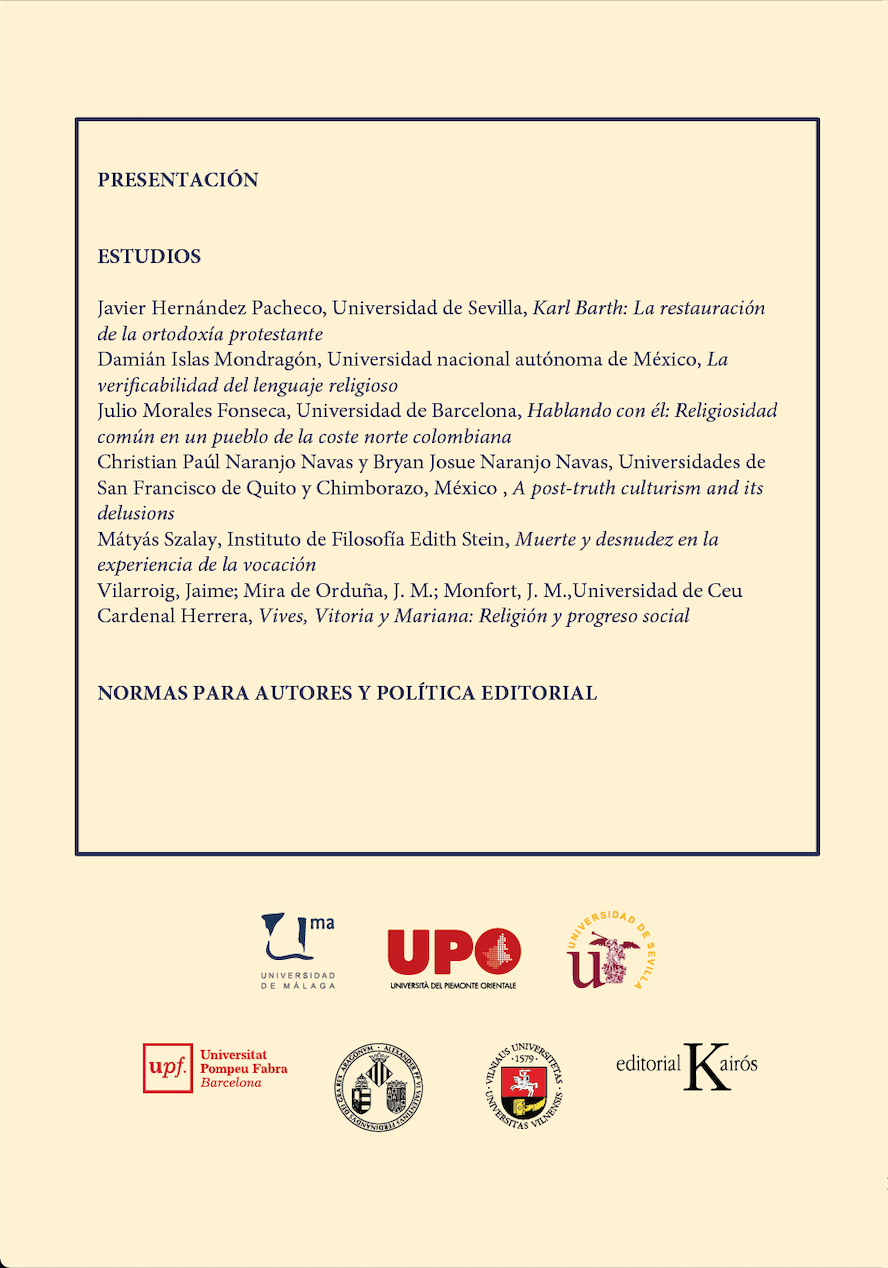MUERTE Y DESNUDEZ EN LA EXPERIENCIA DE LA VOCACIÓN
DOI:
https://doi.org/10.24310/Raphisa.2019.v0i5.5430Palabras clave:
VOCACIÓN, FILOSOFÍA, ESTÉTICA, MUERTE, DESNUDEZ, CASORATIResumen
Este breve ensayo complementa en aspectos esenciales la argumentación de mi libro Introducción a la filosofía de la vocación en la medida en que se analiza la experiencia de la vocación desde el punto de vista de la estética. Me centro en cinco preguntas con respecto a la obra de Felice Casorati titulada Vocation. Primero, partiendo del título de la obra en relación con la desnudez de la figura ilumino la diferencia entre una interpretación santa y profana. En el segundo capítulo intento captar y describir el sujeto de la vocación, uno de las protagonistas de este drama. El tercer capítulo está dedicado a caracterizar el contexto de la vocación con atención especial a la esperanza. El siguiente punto trata del análisis de la experiencia temporal de la vocación. El quinto paso es un nuevo acercamiento a la pregunta más esencial: ¿quién es el que llama en la vocación? El último punto es una recogida de los resultados, es decir, aquellos aspectos esenciales que nos sirven como puntos orientativos para vivir y expresar mejor la vocación como pleno sentido de la existencia.
Descargas
Métricas
Citas
? G. BERTOLINO, F. POLI, V. CARIOGGIA, “Memorie su Felice Casortai” (Canale Arte, 2013) en: https://www.youtube.com/watch?v=RTjy6yCRMNQ (2016.08.08.)
? P. D. AREOPAGITA, “De divinis nominibus”, en B. R. SUCHLA (dir.), De divinis nominibus (Walter de Gruyter, 1990), IV, 7, 135.
? U. ECO Arte y belleza en la estética medieval (Editorial Lumen, Barcelona, 1997
? J. L. CHRÉTIEN, The call and the response. No. 33. (Fordham Univ. Press., 2004)
? H. BALTHASAR, Herrlichkeit: Schau der Gestalt. I. (Johannes Verlag, 1961).
? H. BYUNG-CHUL,Transparenzgesellschaft (Matthes&Seitz, Berlin, 2012)
? H. BYUNG-CHUL, Die Errettung des Schönen(Fischer Verlag, Frankfurt am Main, 2015).
? F. MERINO ESCALERA, “La vocación de la mujer y el feminismo de Edith Stein”, en Cuadernos de Pensamiento: Vol. 13. (1999)93-109.
? R. M. RILKE, “Archaischer Torso Apollos” , en R. M.RILKE, Werke in drei Bänden , Vol. 3. (Insel, 1966)
? H. L. KESSLER, “Turning a Blind Eye: Medieval Art and the Dynamics of Contemplation”, en The Mind’s Eye: Art and Theological Argument in the Middle Ages (Department of Art and Archaeology, Princeton University, 2006) 413-439.
? R. G. COLLINGWOOD, The principles of art. Vol. 11. (Oxford University Press, USA, 1958).
? H. BALTHASAR, “Theology and Sanctity”, en The Word Made Flesh (San Francisco, 1989) 181-209
? P. HENRICI, “Hans Urs von Balthasar: A Sketch of his life”, en D. L. SCHINDLER (dir.), Hans Urs von Balthasar: His Life and Work (Ignatius Press, 1989) 7-44.
? H. BALTHASAR, “Adrienne von Speyr: Über das Geheimnis des Karsamstags”, en: Internationale Katholische Zeitschrift Frankfurt (1981), 10/1, 32-39.
? H. BALTHASAR, Theologie der drei Tage (Johannes-Verlag, 1990).
? G. BERTOLINO, F. POLI, V.CARIOGGIA, “Memorie su Felice Casortai” (Canale Arte, 2013) en: https://www.youtube.com/watch?v=RTjy6yCRMNQ (2016.08.08.)
? J. CHÁNTILLON, “NudumChristusnudussequere. A Note on the Origins and Meaning of the Theme of Spiritual Nakedness in the Writings of S. Bonaventure”, en S. BONAVENTURA 1274-1974 4. vols. (Grottaferrata Collegio S. Bonaventura, 1974) 719-772.
? R. GRÉGOIRE, “L’adage ascétique ’Nudus nudum Christum sequi”, en Studi storici in onore di Ottorino Bertolini, 1. vol. (Pisa, Pacini, 1972) 395-409.
? F. MORANDO, “Nudusnudum Christum Sequi. The Franciscans and Differing Interpretations of Male Nakedness in Fiftheen Century Italy”, en E. E.DUBRUCK, B. I. GUISICK, Fiftheen Century Studies. Vol. 33. (CadmenHouse, Suffolk, 2008), 171-198.
? K. CLARK, The Nude. A Study in Ideal Form (John Murray, London, 1956)
? M. PROUST, Sodome et Gomorrhe (le livre de poche, 2012).
? H. DE LUBAC, Le mystère du surnatural (Editions Aubier Montaigne, Paris, 1965).
? B. BLESAN, “Devenir cuerpo en la sociedad de consumo”, en Revista Internacional de Filosofia, No 66 (2015) 121-133.;
? F. HADJADJ, La profondeur des sexes: pour une mystique de la chair (du Seuil, 2008)
? J. M. FIDALGO, “Fabrice HADJADJ, La profundidad de los sexos. Por una mística de la carne, Granada: Nuevo Inicio, 2010, 302 pp.” en ScriptaTheologica 44/1(2015) 259.
? M. CHRISTENSEN, J. WITTUNG (dir.), Partakers of the Divine Nature. The History and Development of Deification in the Christian Tradition (Farleigh Dickinson University Press., 2006), en: http://www.sgtt.org/Writings/Patristics/Deification.html (07.10.2016).
? ATHANASIUS, De Incarnatione. 54 en: E. P. MEIJERING, Saint ATHANASIUS, J. C. M. VAN WINDEN. Athanasius, De incarnatione verbi: Einleitung, Übersetzung, Kommentar. (JC Gieben, 1989)
? GREGORIO DE NISA, Orationes
? B. MEZEI, Vallásbölcselet. A vallásvalósága (I-II), (Attraktor, Máriabeseny?-Gödöll?, 2004).
? J.A. MCGUICK, “Deification in Greek Thought: The Cappadocian Fathers’ Strategic Adaptation of a Tradition”, en M. J. CHRISTENSEN, A. W. JEFFERY, Partakers of the Divine Nature: The History and Development of Deification in the Christian Traditions, (Baker Academic, 2008)
? F. NIETZSCHE, Über Wahrheit und Lüge im außermoralischen Sinn:[Was bedeutet das alles?], (Reclam Verlag, 2015).
? J. RATZINGER, Jesus of Nazareth: Holy Week: From the Entrance into Jerusalem to the Resurrection. Trans. Vatican Secretariat of State (Ignatius, San Francisco, 2011).
? San. AGUSTÍN, Las confesiones (Ediciones AKAL, 1986)
? M. HEIDEGGER, Phänomenologie des religiösen Lebens. Gesamtausgabe, Vol. 60. en M. JUNG, Th. REGEHLY, C. STRUBE (dir.), (Vittorio Klostermann, Frankfurt am Main, 2011). II. Parte
? D. HILDEBRAND, Die Umgestaltung in Christus. Gesammelte Werke, Vol . 10. (von Hildebrand-Gesellschaft, 1971) 70.
? H. DE LUBAC, Le mystère du surnatural (Editions Aubier Montaigne, Paris, 1965).
? J. H. MCKENNA, “Theology of Adoration”, en: Vincentiana, 49/1, (2005), Article 16.
? San AGUSTIN, Sermo. 88.6 PL 38542. in: D. L. Schindler, Hans Urs von Balthasar: his life and work, (Ignatius Press, 1991) 43.
Descargas
Publicado
Cómo citar
Número
Sección
Licencia
Los textos publicados en Raphisa son de dominio público. Tras la publicación en RAPHISA, los autores mantienen todos los derechos de autor, sin restricciones, y el copyright de sus textos.






